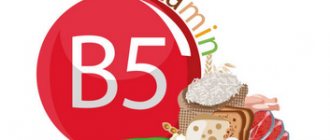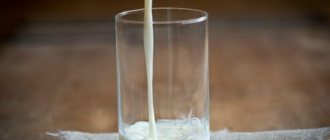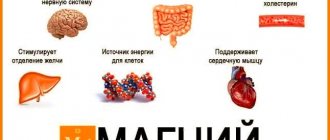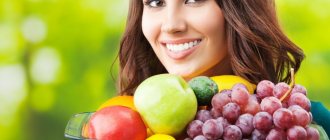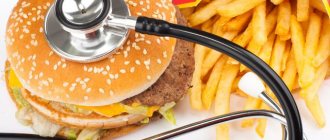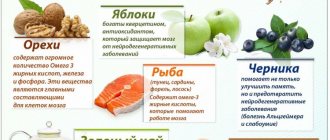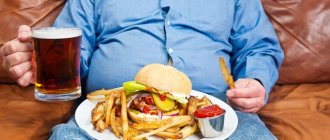Iron deficiency anemia is the most common disease caused by a lack of microelements.
Children and women of childbearing age are most susceptible to it. This type of anemia develops due to a lack of iron in the diet, after severe blood loss, or as a consequence of vitamin C deficiency. There are other types of anemia, for example, megaloblastic, caused by insufficient intake of vitamin B12 and folic acid.
The main task of iron in the body is to participate in the formation of hemoglobin, which concentrates approximately two-thirds of all Fe and carries out gas exchange. Another quarter of iron reserves is stored in the protein ferritin and about 5% in other proteins.
Benefits for the body
Iron obtained from food supplies a number of processes in the human body. Given the special significance of the substance, it is worth dwelling on its functions in more detail.
Hemoglobin formation
Content:
- Benefits for the body
- Why is deficiency dangerous?
- Factors contributing to the development of iron deficiency
- Combination with other nutrients
- The body's needs for iron
- Products containing ferrum
- How to preserve iron in food
- Iron absorption
This ability is one of the main functions of the ferrum. A person constantly needs continuously functioning hemoglobin, especially against the background of blood loss as a result of even minor external or internal bleeding, which reduces its level.
Women in particular regularly experience significant blood loss, making them more susceptible to anemia than men. The problem manifests itself especially clearly with an incorrect, unbalanced diet.
In addition, it is the iron in hemoglobin that transports oxygen throughout all cells of the body.
For muscle formation
In muscle tissue, iron plays the role of an oxygen supplier, without which the process of muscle contraction is impossible. If the muscles do not contract and relax, movement will become impossible.
Ferrum determines muscle tone and elasticity, and weakness is a typical symptom of iron deficiency.
For the brain
The ability to transport oxygen throughout the body makes iron an essential trace element for proper brain function. Fe deficiency increases the risk of developing Alzheimer's disease, dementia and other diseases caused by brain disorders.
Restless legs syndrome
Most researchers agree that the cause of the development of this sensorimotor disease in some cases is insufficient iron intake. Deficiency causes muscle spasms, which intensify during periods of rest (sleep, sitting).
Maintaining a Healthy Body Temperature
Interestingly, iron has the ability to regulate body temperature. And the adequacy of enzymatic and metabolic processes depends on its stability.
To maintain well-being
Eliminates chronic fatigue in men and women, which is also a consequence of low hemoglobin.
Strengthening the immune system
Ferrum plays a key role in the functioning of the immune system. The body, saturated with iron in sufficient quantities, is able to more actively fight infectious diseases. In addition, the speed of wound healing depends on iron.
Healthy pregnancy
During pregnancy, the female body experiences a need for increased volumes of blood and red blood cells (to supply the growing fetus). Therefore, the need for connection in pregnant women increases. Iron deficiency increases the risk of premature birth, provokes underweight in the newborn and disturbances in its development.
In addition, iron can influence energy metabolism, enzymatic activity, relieve insomnia, and increase concentration.
Is it possible to increase iron absorption?
Even in a completely healthy person with a properly formulated, balanced diet, iron is not absorbed very effectively. The human body is able to absorb no more than 10% of the iron contained in food. Even if a person experiences an increased need for Fe, more than 2.5 mg will still not be absorbed by his body.
In men, out of 20 mg of Fe obtained from food, only about 2 mg can be absorbed. A lot of iron is lost in urine and feces, and excreted in sweat. Women can absorb only about 1.3 mg of 15 mg of iron obtained from food. Women lose a lot of iron during menstruation. Particularly serious losses are observed during childbirth and lactation. For comparison, Fe loss during menstruation can be about 30 mg, and during childbirth - about 800 mg.
To make the process of iron absorption as efficient as possible, you need to know which vegetables and fruits contain the most iron, and be able to correctly compose a diet, following the rules for combining foods. It is also important to prepare food properly in order to retain valuable microelements during heat treatment.
By following simple recommendations, you can improve your diet results:
- to reduce iron losses when cooking food, it is recommended to use cast iron cookware (losses are reduced by almost 20 times);
- B vitamins (B6, B9 and B12) help increase the absorption of iron, so it is recommended to combine iron-containing foods with sources of vitamin B6 - nuts, seeds, avocado, prunes, vitamin B9 - broccoli, spinach, asparagus, B12 - eggs, hard cheese, seafood ;
- improves the absorption of iron zinc, it is found in fish, squid, nuts, buckwheat, beans, rye bread;
- molybdenum is present in enzymes that improve the absorption of Fe, it is also present in natural products: parsley, rice, beans, tomato juice;
- copper and cobalt improve the process of red blood cell production, copper is found in nuts, avocados, seafood, and offal, spinach and chicory are rich in cobalt;
- aromatic herbs such as thyme, mint and anise contain substances that improve iron absorption;
- salted vegetables, such as sauerkraut and pickled cucumbers, increase fermentation during digestion and lead to a decrease in stomach pH, which improves Fe absorption;
- onions and garlic are sources of sulfur, which improves iron absorption by 70%.
Note: some dietary habits impair iron absorption. It is not recommended to drink tea or coffee immediately after eating. These drinks contain tannins and caffeine, which reduce the effectiveness of iron absorption.
Vitamin C
It is known that vitamin C improves the absorption of iron, so nutritionists recommend creating a diet so that both iron-containing foods and sources of ascorbic acid are present in one meal. The main sources of vitamin C are citrus fruits, bell peppers, cauliflower, broccoli, blueberries, rose hips, strawberries, and currants.
Note: a glass of orange juice drunk with a meal increases the efficiency of Fe absorption from foods eaten by almost 2 times.
Iron blockers
Some foods contain substances that impair the absorption of iron. Calcium is considered a blocker. Products with calcium (cottage cheese, milk, cheese) are not recommended to be combined with iron-containing ones, as this impairs the absorption of beneficial microelements. Avoid a glass of milk after meals, coffee with cream, or a mug of cocoa.
Iron absorption may also be impaired by foods containing phytins in the diet. These include bread and cereals.
Important! If you consume too much iron, its absorption will also be blocked. Everything is good in moderation.
Daily distribution
The body can only absorb a limited amount of iron at one time. To increase the efficiency of absorption of foods rich in iron, it is recommended to distribute them evenly throughout the day. Add iron-containing foods to your daily diet for breakfast, lunch and dinner, including the vegetables and fruits listed below.
Why is deficiency dangerous?
Anemia is usually the result of Fe deficiency. The main symptoms of iron deficiency:
- fast fatiguability;
- muscle weakness;
- shortness of breath with slight exertion;
- perversion of taste;
- heavy menstrual bleeding in women (can be considered both a symptom and a cause at the same time).
As already noted, women are more susceptible to developing iron deficiency. Almost 10% of the fairer sex of childbearing age suffer from a lack of this microelement. But in men (and in women after menopause), ferrum deficiency anemia is less common. Children are also at risk of developing pathology.
Factors contributing to the development of iron deficiency
The most common reasons:
- Increased blood loss (including from donors) increases the body's need for iron.
- Strength and endurance exercises require nearly doubling your daily ferrum intake.
- Mental activity contributes to faster consumption of iron reserves.
- Diseases of the gastrointestinal tract, gastritis with low acidity, autoimmune intestinal diseases can cause poor iron absorption.
Combination with other nutrients
Vitamin C. Consuming ascorbic acid along with iron-containing foods promotes increased absorption of iron. For example, if you add half a grapefruit to your Fe diet, your body will absorb three times more iron. Therefore, it is important that the menu is enriched not only with iron, but also with vitamin C. However, it is worth paying attention: ascorbic acid has a stronger effect on the absorption of iron from plants than on the absorption of ferrum of animal origin.
Vitamin A: Retinol deficiency blocks the body's ability to use iron stores to form red blood cells.
Copper. This microelement is known to be necessary for the transport of useful substances from storage sites to cells and organs. With a lack of copper, iron loses its ability to move, which results in the development of anemia. Would you like to replenish your ferrum and copper reserves at the same time? Beans, soybeans and lentils should appear regularly on your table.
It is also important to combine foods rich in iron with foods containing B vitamins (thanks to ferrum, B-substances acquire increased chemical activity).
Many food components can inhibit (weaken) the absorption of iron by binding it in the gastrointestinal tract. A number of such components are found in whole grains and black tea. However, studies have shown that it is difficult for a healthy person to be harmed by these substances. But in people with existing disorders of iron absorption or with developed anemia, absorption deteriorates even more.
It is also important to know that calcium almost completely blocks the absorption of iron. Hence the recommendation: for normal absorption of ferrum, consume iron-containing foods separately from dairy foods and other foods rich in calcium.
Iron-rich berries
Berries rich in iron can become a valuable food product for anemia. They contain a set of vitamins and microelements necessary for health, provide the body with energy, and increase its tone.
Mulberry
100 g of mulberries contain about 1.9 mg of iron. During the mulberry ripening season, it is recommended to eat the berries as often as possible. They will prevent anemia and improve oxygen transport in tissues.
They are also good for the health of the circulatory system. Mulberries normalize heart rate and blood pressure. The antioxidant resveratrol contained in blue-black fruits improves the condition of blood vessels, reduces their susceptibility to damage, and reduces the likelihood of stroke and heart attack. Mulberries are rich in vitamin C. It fights free radicals and strengthens the immune system.
Raisin
Raisins are not often eaten in their pure form, unlike other dried fruits. Most often it is added to baked goods, casseroles, and compotes. But even after heat treatment, it retains iron that is beneficial for the human body. In 100 g of raisins its content reaches 3 mg.
To increase the benefits of eating raisins, it is recommended to eat them on an empty stomach, in their pure form. Fans of traditional medicine claim that this method of consuming raisins helps the body cope with heart disease, improves the functioning of the gastrointestinal tract, and normalizes the functioning of the nervous system. Doctors confirm that raisins are rich in vitamins and microelements that have a positive effect on health.
Blueberry
Blueberries are known as a fighter against impaired vision, and this property has overshadowed many other advantages of the berry. Few people know that blueberries are rich in iron and can prevent the development of anemia with the regular presence of berries in the diet. 100 g of blueberries contain about 0.7 mg of iron in an easily digestible form.
Black currant
Blackcurrant is the record holder among berries for the content of vitamin C. It does not contain much iron, so be it! After all, iron obtained from other foods will be absorbed many times better if black currants are present in the diet.
For anemia, it is recommended to eat fresh and dried currants and drink juice from them. In addition, blackcurrant leaves are rich in vitamin C. Useful decoctions and infusions are prepared from them.
Raspberries
Among the seasonal berries growing in our country, raspberries are always considered one of the healthiest. It is more effective than many drugs in coping with various ailments, strengthening health and immunity. Raspberries have more iron than many other berries. Depending on the variety, the berries contain from 2 to 4 mg of iron. The maximum benefit can be obtained if you eat them fresh, but raspberry jam, as well as dried fruits, are considered a valuable source of nutrients.
The body's needs for iron
The daily iron requirement for adults ranges from 10-30 mg.
Nutritionists call a serving of Fe of 45 mg the acceptable upper limit. At the same time, the daily norm for women is slightly higher than for men. This is explained by physiological processes: from 10 to 40 mg of iron are lost monthly with menstrual blood. With age, the female body's need for ferrum decreases.
In healthy people, iron overdose is almost never observed. People with hemochromatosis (a genetic disorder in which the percentage of iron absorption from food is 3-4 times higher than in healthy people) are at high risk of poisoning. Excessive accumulation of ferrum in the body can activate free radicals (damage liver, heart, pancreas cells, increasing the risk of cancer).
Products containing ferrum
There are 2 types of iron in food: heme and non-heme. The first option is ferrum, which is part of hemoglobin. Its sources are all foods of animal origin and seafood. Heme iron is absorbed faster and easier by the body. Non-heme iron is an element obtained from plant foods. It is used only partially for the formation of hemoglobin, and then only in combination with vitamin C.
To achieve maximum benefits, nutritionists recommend combining foods of animal and plant origin. In this way it is easy to increase the absorption of ferrum (sometimes up to 400%).
Many people know that meat, especially red meat, as well as offal, are the best sources of iron.
Plant foods can also provide enough iron. True, for this it is important to eat a wide variety of foods of non-animal origin.
Research partially debunks the theory that plants cannot provide enough iron to humans. Many vegetarian foods contain iron in amounts greater than 10% of the daily value, and a serving of spinach or lentils will provide a third of the daily value.
Plant foods contain fewer calories and fats, so they are ideal for people watching their figure and health. But, besides this, adherents of vegetarianism do not deny that the recommended daily intake of iron obtained exclusively from plant foods should be approximately one and a half times higher than that of meat eaters.
Among plant foods, the best sources of iron are legumes and green leafy vegetables. Whole grains also have good nutritional properties and good reserves of ferrum. And the most unexpected source of iron for many is sugar cane molasses. Just 1 teaspoon of this product contains almost 1 milligram of iron. This figure is significantly higher than that of other sweeteners such as honey, maple syrup, and brown sugar.
To make it easier to understand which foods are most saturated with iron, we offer a table.
Using this knowledge, it is easy to avoid iron deficiency anemia. Best Sources of Heme Iron
| The product's name | Quantity | Iron content (mg) |
| Pork liver | 200 g | 61,4 |
| Beef liver | 200 g | 14 |
| Beef kidneys | 200 g | 14 |
| Mussels | 200 g | 13,6 |
| Oysters | 200 g | 12 |
| Heart | 200 g | 12,6 |
| Rabbit meat | 200 g | 9 |
| Turkey | 200 g | 8 |
| Mutton | 200 g | 6,2 |
| Chicken | 200 g | 5 |
| Mackerel | 200 g | 5 |
| Ground beef (lean) | 200 g | 4 |
| Herring | 200 g | 2 |
| Chicken egg | 1 piece | 1 |
| Quail eggs | 1 piece | 0,32 |
| Black caviar | 10 g | 0,25 |
Best Sources of Non-Heme Iron
| The product's name | Quantity | Iron content (mg) |
| Peanut | 200 g | 120 |
| Soybeans | 200 g | 10,4 |
| Beans (lima) | 200 g | 8,89 |
| Potato | 200 g | 8,3 |
| White beans | 200 g | 6,93 |
| Beans | 200 g | 6,61 |
| Lentils | 200 g | 6,59 |
| Spinach | 200 g | 6,43 |
| Beetroot (tops) | 200 g | 5,4 |
| Sesame | 0.25 cups | 5,24 |
| Chickpeas | 200 g | 4,74 |
| Romaine lettuce | 200 g | 4,2 |
| Chard | 200 g | 3,96 |
| Asparagus | 200 g | 3,4 |
| Brussels sprouts | 200 g | 3,2 |
| Pumpkin seeds | 0.25 cups | 2,84 |
| Caraway | 2 tsp | 2,79 |
| Beet | 200 g | 2,68 |
| Turnip | 200 g | 2,3 |
| Leek | 200 g | 2,28 |
| White cabbage | 200 g | 2,2 |
| Green pea | 200 g | 2,12 |
| Broccoli | 200 g | 2,1 |
| Olives | 200 g | 2,1 |
| Zucchini | 200 g | 1,3 |
| Tomatoes | 200 g | 0,9 |
| Parsley | 10 g | 0,5 |
| Chilli | 10 mg | 1,14 |
| Oregano | 2 tsp | 0,74 |
| Basil | 10 g | 0,31 |
| Black pepper | 2 tsp | 0,56 |
Tables of iron content in animal products
The first table we prepared shows which foods contain the most iron. The highest iron content per 100 g is found in products of animal origin, but not meat, but the spleen, liver, kidneys, hearts and lungs of livestock, as well as poultry offal.
Table 1. Iron content in meat and offal
A few notes:
- Unlisted raw lungs and kidneys contain approximately the same amount of iron as raw liver.
- In unspecified parts of beef there is an average of 2.5 to 3.5 mg of iron per 100 g of product prepared by any method, in lamb - from 1.6 to 2 mg, in veal and turkey - on average 1-1.5 mg, in chicken – 1.4 mg, the least – in pork (0.5-1.5 mg).
- Game meat has a significantly higher iron content than domestic animals and poultry.
- Vegetarian meat substitutes contain on average 12 mg of iron per 100 g of product with a calorie content of 311 kcal.
Also read: What oil to fry in without harm to health
Other animal foods that contain large quantities of iron are shellfish, caviar, algae, fish and crustaceans.
Table 2. Iron content in fish and seafood
Table 3. Other animal foods high in iron
How to preserve iron in food
Among the advantages of iron contained in food of animal origin is high heat resistance. But plant ferrum does not tolerate mechanical processing or cooking. An example is whole grains, which lose almost three-quarters of their Fe reserves during processing into flour.
If we talk about cooking, then in this case the iron from the product does not evaporate - it partially passes into the water in which the vegetable was cooked. It is also important to know a few tricks that will help preserve iron in your dishes.
1. It is possible to minimize losses by reducing the cooking time and using as little water as possible. Example: spinach boiled for 3 minutes in a large saucepan loses almost 90% of its iron.
Best materials of the month
- Coronaviruses: SARS-CoV-2 (COVID-19)
- Antibiotics for the prevention and treatment of COVID-19: how effective are they?
- The most common "office" diseases
- Does vodka kill coronavirus?
- How to stay alive on our roads?
2. Cast iron cookware can add extra iron to foods. These portions can be very small - from 1 to 2 milligrams, but the reality of such a process has already been proven. Moreover, experiments have shown that acidic foods more intensively absorb ferrum from such containers.
What can pregnant women eat?
Considering which fruits contain the most iron, a balanced diet is prepared for pregnant women. Expectant mothers are advised to regularly eat apples, pomegranates, plums, pears, and bananas.
It is very useful for a pregnant woman to drink pomegranate juice. However, the amount of drink needs to be controlled. Excessive consumption may cause constipation.
To improve the absorption of iron-containing foods, pregnant women should give up black tea and replace it with green tea. It would be even better to give up caffeine-containing drinks completely, and instead drink dried fruit compotes, rosehip decoction, jelly, berry juices and fruit drinks.
In addition, pregnant women are recommended to consume small amounts of honey. 1 – 2 teaspoons of honey will increase the efficiency of iron absorption, and also strengthen the expectant mother’s immunity and help her resist colds in the autumn-winter period. The main thing is not to overuse it, since honey is considered an allergenic product.

